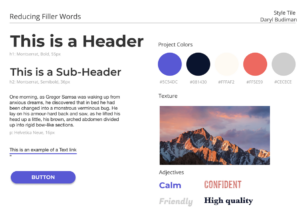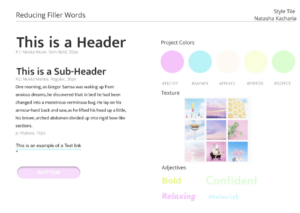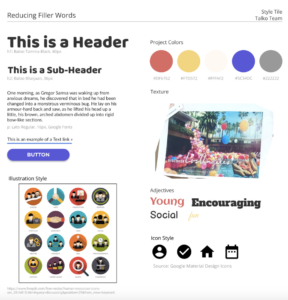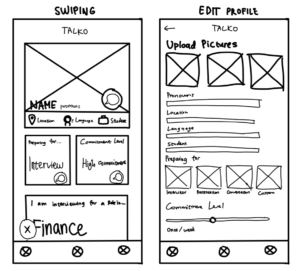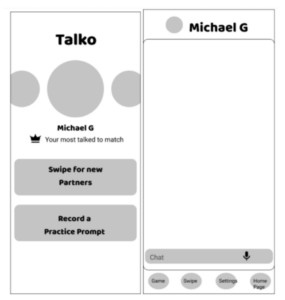Problem Finding
a) Justification for choosing problem
Earlier this year, Natasha’s dad emailed her a list of credibility undermining words and phrases. Upon glancing at the list, she realized that she utilized most of them in my everyday life. This inspired our team to tackle the behavior change of reducing filler words and credibility undermining words in everyday speech. However, after pre-interviews and the baseline study, we realized that this was a behavior that everyone wanted to change. Thus, we modified our problem scope to helping young adults and students feel more confident in their speech by reaching goals of their choosing, like reducing filler words or improving pacing.
b) What is known about the problem?
Many current researchers explore the intersection between how a person’s identity (race, gender, and whether English is their first language) relates to a person’s speaking patterns. For instance, when listening to vocal fillers, although both genders viewed them negatively, males perceived vocal fillers significantly more negatively than females in speeches. A female participant in our diary study said, “she’s conditioned to want to take less space in the room”; therefore, she “intentionally uses more filler words to appear less assertive.” An African American participant in our study said he “always feels conscious” about his word choices, and he tries to imitate his “confident friends” – mostly white friends – in speaking. Both primary and secondary research indicates that speech is not indicative of a person’s intelligence or credibility; however, we live in a society that favors whiteness, and in turn American standards of speaking. American society considers filler words to be “credible undermining” language, and some identities are more susceptible to judgment.
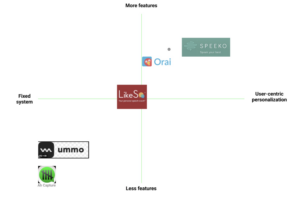
c) Baseline Study
In the pre-interview, many potential users indicated that they felt underprepared in formal speech and interviews. Thus, for our baseline study, we sent two interview questions a day to our participants in which they would respond with a minute response. Our team would proceed to listen to the recording, noting down the number of filler words and credibility undermining words in their response, as we wanted quantitative data that is easy to compare. Additionally, we would send a post-interview questionnaire to see if there was a correlation between the number of filler words/credibility words and external factors: stress, frequency of the problem.
d) Synthesis
Through our base-line study, we created two personas: Stressed-Out Sally and Approachable Amy. While Sally’s usage of filler words and credibility undermining words stem from her nerves and lack of self-confidence when giving formal speeches, Amy utilizes filler words and hedges her speech in order to seem more approachable and welcoming to the audience. Due to the short-time of this project, we decided to focus on Sally, as she aims to be a more confident speaker. 
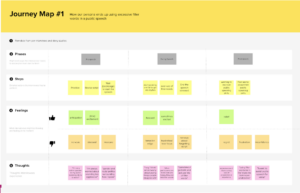
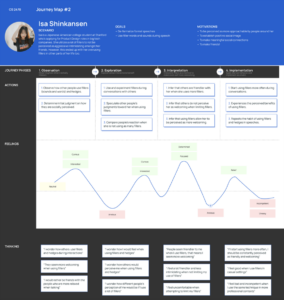
Solution Finding
a) Ideating and Picking an Intervention
As a group, we chose our two interventions during a brainstorming session: accountability partners and plant-mediated therapy.
Accountability Partners + Practice: Our first intervention study was accountability partners in order to encourage practice between users. This decision was motivated by a literary review that affirms that consistent speech practice leads to lower use of fillers, and the data of baseline study: the participants’ fillers/minute count decreases day by day.
Plant-Based Therapy: Our second intervention study was plant-based therapy in which users interacted with a virtual plant before speech. We chose this intervention because the baseline study showed a correlation of participants feeling “stressed” and the utilization of hedges and fillers, and a research paper found that interacting with plants decreases anxiety levels and increases calmness in people.
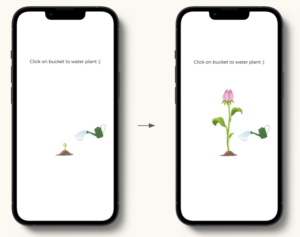
b) Intervention Study
For 5 days, we recruited 6 participants for 2 different interventions with 3 participants doing each intervention. The speech partner intervention was carried out by having participants do a speaking practice prompt with a speech partner (members of our group) and then receive feedback from them. At a later time, they would receive a different prompt and be asked to record their 1-3-minute response to that prompt individually. The plant intervention study was carried out by having our participants water a virtual plant using the Figma prototype that our team designed (https://tinyurl.com/plantspeak). Then, they would receive a prompt and be asked to record their 1-3 minute response. For both studies, we also followed up the exercise with questions pertaining to their mood and relaxation levels.
From the speech partner intervention, we learned that participants felt confident when their accountability partner provided feedback in the form of positive affirmations (e.g. great job, you spoke fluently without fillers) when they completed a good speech but annoyed if the partner jumps in to critique before they finish talking. Based on collected data, having an accountability partner reduced the frequency of fillers (compared to the baseline study). For the plant intervention study, there were less significant improvements. Participants felt it is a great distraction before formal speech but would appreciate long-term habit changing plans. From both studies, we learned that a participants’ active awareness and willingness to reduce fillers are the most important in changing speaking patterns.
In hindsight, we would have utilized a therapeutic intervention that has more scientific evidence of having calming effects on users such as mindfulness meditation and explored how this practice can be incorporated in a way that’s as accessible to users without a background in meditation (the reason why we chose plant therapy was because it has a low barrier of entry to learn). Then, we would explore the effects of combining mindfulness with accountability partners where users practice meditation with a partner, given both concepts are backed by evidence.
c) Mapping
Over the course of this project, we did several mapping exercises:
- Story Map: Helped us identify the fluctuation of emotion of our users’ experience with using fillers, what features can accommodate a specific emotion.

- Bubble Map: Allowed us to explore subcomponents and additional features that can help our users achieve the ultimate goal of gaining more confidence in speech (e.g. learning goals, expected commitment, etc.).
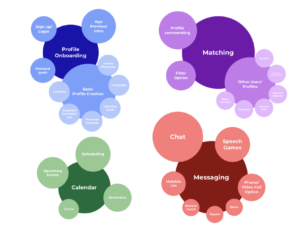
- System Path Diagram: Allowed us to design the app to accommodate different types of users (e.g. app setting is set to English as the default language, but we added a feature to change the language settings for users who want to practice speaking for other languages)

- System Map: Helped us identify the root causes of excessive use of fillers (e.g. stress, audience, perceived importance of speech) and the main goals that we should focus on (e.g. increasing user confidence, encouraging practice)
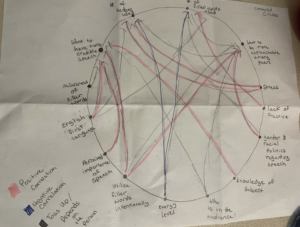
From these mapping exercises, we found the bubble map and system map to be the most helpful because they allowed us to define the goal of our app (increase user confidence) and specify the steps and features necessary to help our users achieve this goal. We will utilize all four of these mapping exercises in the future, but with more emphasis on bubble maps and system path diagrams.
d) Assumption Mapping
We used “level of importance” and “amount of evidence” to lay out our assumptions of our app. We learned that most of our assumptions are either in the category of “high importance and little evidence” or “high importance and much evidence”. We decided to explore the following two assumptions because both scored high on level of importance but low on amount of evidence, thus having the need to test them:
1. Having an accountability partner encourages users to practice more
- We chose this assumption because there is evidence that having friends as your accountability partner as a friend increases motivation, but our application matches strangers.
- Question: How are accountability partners ranked in relation to other motivational factors of practicing speech?
- Hypothesis: Accountability partners will be ranked relatively high.
- Design: 1-on-1 interviews with participants to gain insight to their opinions on accountability partners
- Result: Participants need clarity on who the accountability partner is. They feel comfortable if the partners are their friends and will be motivated to practice. They do not prefer complete strangers.
- Moving forward: Design features that allow matches to get to know each other on a more personal level and gain friendship.
2. Users will be interested to download and use our app
- We chose this assumption because we wanted to see if the concept of a matchmaking app for speaking partners would actually garner interest.
- Question: Will an app advertisement encourage people to learn more about our app?
- Hypothesis: A few users would be interested in our app from our advertisement while some will scroll past through.
- Design: Users receive a NY Times article about fear of public speaking, with our app advertisement incorporated inside the article. Observe if users click on the ad.
- Result: Out of 2 users, 1 clicked on the ad. One user indicated that the ad was the main thing that caught their attention while reading the app, primarily because they were interested in the topic of improving speech. The other user scrolled past because they dislike seeing ads in general and are not interested in improving speech.
- Moving forward: This assumption testing made us aware that not all users will be interested in our app; hence, we need to strategize the design of our app to fit a narrow target audience of users who intend to improve speech rather than creating a general matchmaking app. This means creating more specific features that can improve speech confidence (e.g. calendar to schedule speech-related events, speaking prompts).
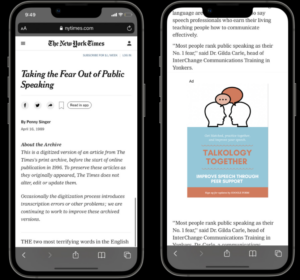
Designing the Solution
a) Wireflows
We made wireflows for our four main features – onboarding, swiping, messaging, and calendar. From the wireflows, we realized our features are still disconnected from each other, and that we need to elaborate on how we guide users through different pages. The wireflows also helped us realize and clarify that our app has two main functions: the first is to help users build connections with others with like-minded goals through the swiping and matching interface; the second is to help users improve their speech abilities through the calendar interface and “speech games” feature in messaging interface. We decided we wanted to focus on the “building connection” function as the next step as that could distinguish us from other speech apps.
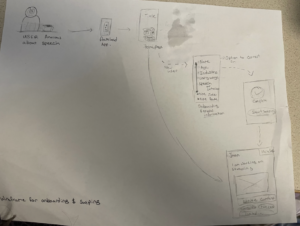
Fig 3.1 onboarding & swiping wireflow
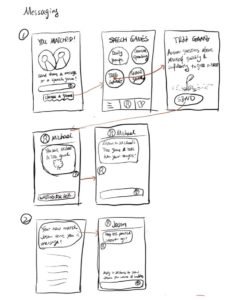
Fig 3.2 messaging wireflow
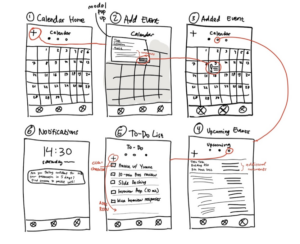
Fig 3.3 calendar wireflow
Link to detailed documentation: https://highercommonsense.com/cs247b/team-8-wireflow-and-elaboration/
b) Moodboards and Style Tiles
1. Moodboard
From the in-class moodboard, we decided that we want to convey the feeling of young, fun and professional in our app. Speech practice has always been viewed as boring and we hope our app can change that perception.

Fig 3.4 Moodboard made in class
2. Individual Style Tiles
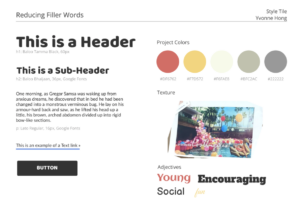
Fig 3.5 Yvonne’s Style Tile
Fig 3.6 Daryl’s Style Tile
Fig 3.7 Natasha’s Style Tile
3. Link to writeup of Moodboard & Individual Style Tiles:
https://medium.com/@nkacharia/experiment-synthesis-1dca69de2e3b
4. Final Style Tile
After seeing our teammates’ individual style tiles and getting feedback, we decided to combine Daryl and Yvonne’s style tiles. We felt like Yvonne’s style tile conveys a more young and fun feeling in general, but we realized the colors did not have high contrast. To solve that issue, we added the purple color from Daryl’s style tile as the action color.
Our team had conflicting opinions on which background color to use, and we conducted a quick user test (https://lnkd.in/gEtURUDZ) to test user preferences.
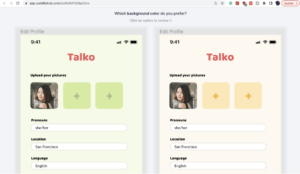
Fig 3.8 User Preference Test Example Page
Fig 3.9 Final Style Tile
c) Sketchy Screens
We included the features of onboarding, swiping and messaging for our sketchy screens. We adopted simplistic and intuitive designs and interfaces that users are familiar with.

Fig 3.10 Onboarding Sketchy Screens
Fig 3.11 Swiping & Profile Sketchy Screens
Fig 3.12 Messaging Sketchy Screens
d) Clickable Prototype
1. We implemented our clickable prototype with three flows: onboarding, swiping, messaging.

Fig 3.13 Clickable prototype overview
2. Link to clickable prototype on figma:
e) Usability Testing/Moving Forward
1. Usability Testing
In our user test, we gave the users tasks to interact with all individual flows we implemented. We asked questions on the aspects of design that we were unsure of, such as “to what extent do you think the swiping page gave you enough information to make the decision to swipe?”
- Link to usability testing script: https://docs.google.com/document/d/1YanOKGV1EMWj-dOYbZoj1CNkWobzZeUwHHaepqrom_A/edit?usp=sharing
2. What were your 3 biggest issues and how would you address them?
- Unclear purpose of application
For an application that focuses on improving speech through practice; the prototype currently focuses on the matching part of the application, leaving a lot of the users confused on how the algorithm works as a matching algorithm. We need to put more emphasis on the action items of speech improvement. Next steps:
- To match with someone, someone sends prompts instead of a simple messaging feature.
- Increase the focus of speech improvement on the homepage by listing out “next steps”
- Finish implementing the Calendar flow and the feature of “Scheduling a practice session” in chat
- Unclear on what the user was signing up for
The user was often unclear on what he/she was ultimately signing up for. This was problematic, as the user could not be helped. Next steps:
- Integrate an illustration that helps illustrate what the purpose of Talko
- Update the slogan on the first screen during onboarding to something that explains the app features more clearly
- Incomplete flows leave users confused about what exactly happens on the app
Next steps:
- Make swiping page swipeable, and show the matching page
- Add pages that show example texts in the signup flow
3. Incorporating feedback from user testing, here is the link to our final prototype: https://www.figma.com/proto/5LZDJ8XtxYOiBKEl3fF6r9/Talko?node-id=154%3A2&scaling=scale-down&page-id=132%3A2&starting-point-node-id=154%3A2&show-proto-sidebar=1
4. What other things would you take into consideration if you were to move forward?
-
- Preferences for matches: we would like to study whether we should implement advanced settings that allow users to choose what type of users they would like to match with based on, for example, gender, occupation and interests. Since our app fosters human connections, we think having this option can help users find others that they feel more comfortable with, and this practice is done and proven effective by many other apps like Shrinkspace and Bumble.
- Business model: we would like to look into viable business models, such as adding paid features, or limit the number of matches the user can have in the free version. We could also incorporate an in-app economy, such as requiring “Talko coins” to review feedback other users give you. Users can gain “Talko coins” through purchase or through giving other users feedback.
- The option to use the app by yourself or to use the app with friends in real life: we are considering implementing a version of the app for people that do not want to meet strangers to practice speech. These users can utilize the random prompt generator and view speech tips on the app. This will make our application more inclusive to shy people. We can also implement the feature of automatically adding your real-life friends as your matches on Talko so they can work on speech together.
Ethical Analysis and Broader Impacts
- Nudging and Manipulation:
The primary facilitation of behavior change is matching users with accountability partners and helping them visualize their next steps through the calendar interface. We started the project wanting to help people reduce credibility-undermining words and filler words in speech in order for people to sound more confident and credible. However, we realized these changes conform to Western American Standard of speaking, and we decided to change the focus of the app to speech improvement in general, and give users the option to choose how they want to improve. However, the tips on Talko to improve speech do conform to the Western American standards of speaking. As we are transparent about the conformation of Western American Standard of speaking and we give users the option to improve on their own standard, these tips would not constitute an evil nudge. In fact, we chose Stressed-Out Sally as our user persona, as she is consenting to the behavior change of improving her speech in this particular way.
- Privacy & Safety:
Since Talko is a social app in nature, we have been careful in finding a balance between privacy and safety. We respect users’ privacy by only collecting information that is necessary for the matching process and related to speech practice. For example, in the final screens, we decided to make uploading a profile picture optional, giving the option for the user to choose a vegetable avatar instead. Yet, other fields like goals like “Preparing for” and “Hoping to Improve” are required. We also believe the required data we collect is unlikely to be useful to other companies and sources.
For users’ safety, we also added a “Report” button in the Messaging interface. We were worried some users might misuse the app for dating or even harassment. We acknowledge that we can never prevent all these misuses from happening but we hope to protect our users through the “Report” mechanism and the focus on speech in our profile making.
- Interface Design & Design Justice:
Firstly, the default language for our app is set to English, primarily because we narrowed down our target audience to be college students and young professionals in the US. However, in reference to Universal Design, we provided an option during the onboarding and edit profile section for our users to change the language of the app simply by entering another language. Secondly, a concern that we had was putting too much emphasis on reducing fillers and hedges. As designers and in reference to Value Sensitive Design, we can’t simply assume that there is a right or wrong in these linguistic techniques and other cultural nuances in language. Thus, we provided the users the freedom to select what they personally intend to “improve on” by incorporating a checkbox structure and having an “other” option to allow users to add their own input. Ultimately, in reference to VSD and Inclusive Design, we incorporated personalization into a lot of the features that Talko has (e.g. optional pronouns, optional photos/avatar). For our project, the right balance would be focusing on universality in the sense of designing our features for college students and young professionals but also allowing personalization for each user to uphold specificity and comfort.
- Design for Well-Being:
We promote well-being according to the Object List Theories. There is no right or wrong way of speaking, but we want to help users learn the speaking skills that would help them professionally and are useful in the professional world. Our project might pose a risk to the well-being of users according to the Hedonism framework – users might find changing their speech habits to be painful or to be pretentious. Having users give up the happiness of the way that they speak can hurt their well-being.
- Broader Impacts:
Speaking habits are closely related to someone’s identity – gender, race, sexuality, and more. If everyone adopts the behavior change of making their speech tailored more towards the professional standards, we risk losing these traces of cultures that are embedded in how people speak.
Conclusion
Bringing Talko together was an incredibly fun experience! Our most important take-away is likely the importance of the testing: assumption and usability; we gained such insightful opinion and thoughts from talking to the teaching team, classmates, and potential users. For our next behavior design effort, we are going to continue working on communication and ways we can make our design more human-centric.

